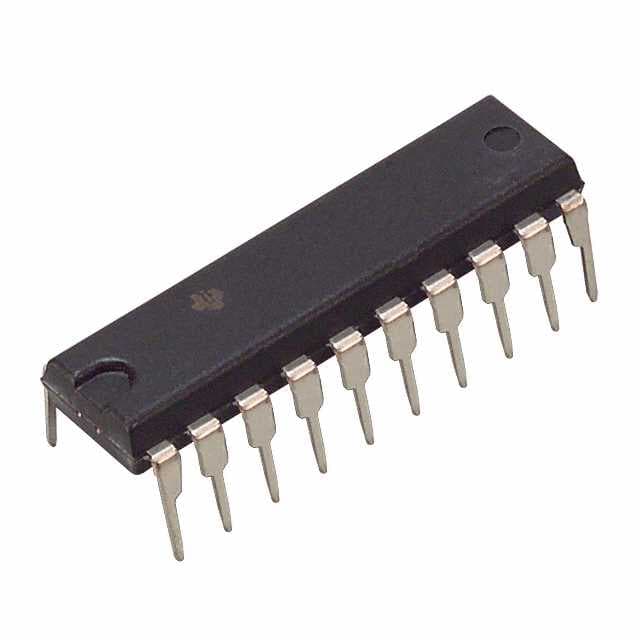Szczegóły produktu można znaleźć w specyfikacjach.

CD74HC688E
Product Overview
- Category: Integrated Circuit (IC)
- Use: Arithmetic Logic Unit (ALU)
- Characteristics: High-speed, CMOS logic, 8-bit magnitude comparator
- Package: DIP-20 (Dual In-line Package with 20 pins)
- Essence: The CD74HC688E is a high-speed CMOS IC that performs 8-bit magnitude comparison. It is commonly used in digital systems for arithmetic and logical operations.
- Packaging/Quantity: The CD74HC688E is typically sold in reels or tubes containing multiple units.
Specifications
- Supply Voltage: 2V to 6V
- Logic Family: HC (High-Speed CMOS)
- Number of Pins: 20
- Operating Temperature Range: -40°C to 85°C
- Propagation Delay: 9 ns (typical)
Detailed Pin Configuration
The CD74HC688E has a total of 20 pins arranged as follows:
- A0: Input pin for the least significant bit of the first 8-bit data word.
- A1: Input pin for the second least significant bit of the first 8-bit data word.
- A2: Input pin for the third least significant bit of the first 8-bit data word.
- A3: Input pin for the fourth least significant bit of the first 8-bit data word.
- A4: Input pin for the fifth least significant bit of the first 8-bit data word.
- A5: Input pin for the sixth least significant bit of the first 8-bit data word.
- A6: Input pin for the seventh least significant bit of the first 8-bit data word.
- A7: Input pin for the most significant bit of the first 8-bit data word.
- B0: Input pin for the least significant bit of the second 8-bit data word.
- B1: Input pin for the second least significant bit of the second 8-bit data word.
- B2: Input pin for the third least significant bit of the second 8-bit data word.
- B3: Input pin for the fourth least significant bit of the second 8-bit data word.
- B4: Input pin for the fifth least significant bit of the second 8-bit data word.
- B5: Input pin for the sixth least significant bit of the second 8-bit data word.
- B6: Input pin for the seventh least significant bit of the second 8-bit data word.
- B7: Input pin for the most significant bit of the second 8-bit data word.
- G: Enable pin to activate the magnitude comparison operation.
- EQ: Output pin indicating equality between the two input words.
- LT: Output pin indicating that the first input word is less than the second input word.
- GT: Output pin indicating that the first input word is greater than the second input word.
Functional Features
- Performs 8-bit magnitude comparison between two input words.
- Outputs signals indicating equality, less than, and greater than relationships between the input words.
- High-speed operation suitable for use in digital systems.
- CMOS logic ensures low power consumption and compatibility with a wide range of devices.
Advantages and Disadvantages
Advantages
- High-speed operation allows for efficient arithmetic and logical operations.
- CMOS technology provides low power consumption.
- Wide operating voltage range (2V to 6V) enables compatibility with various systems.
Disadvantages
- Limited to 8-bit magnitude comparison, may not be suitable for applications requiring larger word sizes.
- Propagation delay of 9 ns may introduce timing constraints in certain high-speed applications.
Working Principles
The CD74HC688E compares two 8-bit data words (A and B) and determines their magnitude relationship. The enable pin (G) activates the comparison operation. The outputs EQ, LT, and GT indicate whether the two input words are equal, the first word is less than the second, or the first word is greater than the second, respectively.
The IC utilizes CMOS logic, which ensures low power consumption and compatibility with a wide range of devices. It operates at high speeds, making it suitable for use in digital systems that require efficient arithmetic and logical operations.
Detailed Application Field Plans
The CD74HC688E can be used in various applications that involve comparing 8-bit data words. Some potential application fields include:
- Microcontrollers: Comparing data values in microcontroller-based systems.
- Digital Signal Processing: Magnitude comparison in signal processing algorithms.
- Data Sorting: Sorting algorithms that require comparing data elements.
- Error Detection: Checking for errors in data transmission by comparing received and expected data
Wymień 10 typowych pytań i odpowiedzi związanych z zastosowaniem CD74HC688E w rozwiązaniach technicznych
Sure! Here are 10 common questions and answers related to the application of CD74HC688E in technical solutions:
Q: What is CD74HC688E? A: CD74HC688E is a high-speed CMOS (Complementary Metal-Oxide-Semiconductor) 8-bit magnitude comparator with internal latches.
Q: What is the purpose of CD74HC688E? A: CD74HC688E is used to compare two 8-bit binary numbers and determine their relative magnitudes.
Q: How does CD74HC688E work? A: CD74HC688E compares corresponding bits of the two input numbers and generates outputs indicating whether one number is greater, equal, or less than the other.
Q: What is the voltage supply range for CD74HC688E? A: CD74HC688E operates within a voltage supply range of 2V to 6V.
Q: What is the maximum operating frequency of CD74HC688E? A: CD74HC688E can operate at a maximum frequency of 25 MHz.
Q: Can CD74HC688E be used in both digital and analog circuits? A: No, CD74HC688E is specifically designed for digital applications and should not be used in analog circuits.
Q: What is the output format of CD74HC688E? A: The output of CD74HC688E is in the form of three control signals: A>B, A=B, and A<B.
Q: Can CD74HC688E handle negative numbers? A: No, CD74HC688E is designed to compare unsigned binary numbers and cannot handle negative numbers directly.
Q: What is the power consumption of CD74HC688E? A: The power consumption of CD74HC688E is relatively low, typically around 10mW.
Q: Can CD74HC688E be cascaded to compare larger numbers? A: Yes, multiple CD74HC688E chips can be cascaded together to compare larger numbers by connecting the carry-out (COUT) of one chip to the carry-in (CIN) of the next chip.
Please note that these answers are general and may vary depending on specific application requirements and datasheet specifications.

